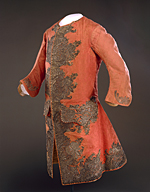| Culture: | fabric: English; garment: American
| | Title: | waistcoat
| | Date Made: | ca. 1759
| | Type: | Clothing
| | Materials: | textile: silver metallic thread embroidery (padded appliqué, wrapped, buillion, paillete and flattened strips), flame-orange figured silk, bleached plain-weave linen lining, bleached plain weave silk lining, silk floss, lacing; cardboard, wood
| | Place Made: | fabric: United Kingdom; England; London (probably); embroidery: England or France; garment: United States; Massachusetts; Springfield
| | Measurements: | overall: 34 1/2 in.; 87.63 cm
| | Accession Number: | HD F.496
| | Credit Line: | Gift of Mrs. Arthur F. Draper
| | Museum Collection: | Historic Deerfield
|
|

|
Description:
Man's flame-orange figured silk, sleeved waistcoat with silver thread embroidery on the facings, front hem, pocket areas, and cuffs. The waistcoat was worn by John Worthington (1719-1800) of Springfield, Massachusetts for his marriage to Hannah Hopkins (1731-1766) of West Springfield in 1759. Their daughter Hannah (1761-1833) married Col. Thomas Dwight (1758-1819), the son of Col. Josiah Dwight (1715-1768) and Elizabeth Buckminister (1731-1798) and a lawyer in Springfield, and the waistcoat descended in the Dwight family. The figured pattern is an abstract feather/scroll and leaf design (technique appears similar to that on the waistcoat, HD F.080). The dense embroidery consists of silver metallic threads over stiffened paper scroll cut-outs, appliquéd onto the ground fabric, resembling guipure or rapport embroidery. The elevation of this handwork off of the salmon-colored silk ground literally highlighted its reflective qualities. Additional wrapped metallic threads (metal wrapped around a silk core), and flattened metallic threads are couched onto the ground. Silver buillion embroidery, pailletes (or sequins), and flattened strips decorate the wooden buttons, which are themselves wrapped in cream-colored silk floss. All the embroidery was done by a professional whose direct contact with the metal had to be minimal to avoid tarnish. As a cost- and labor-saving measure, the embroidery was applied to the garment down the front and on the cuffs, where seen through the coat worn on top. It is possible that the elevated scrolls were embroidered first, then appliqued onto the orange silk, and flatter areas of metallic embroidery were couched on or stitched down in between. There are fourteen rounded buttons on the front closure of the rounded, collarless waistcoat, each decorated with pailletes, and spiral, wrapped silver thread. There are twelve corresponding, worked button holes on a hidden placket (bottom most two buttons are left open). There are two hip level, flap pockets, one on each side, which are scalloped; the pockets underneath are lined in linen.The waistcoat has long, full skirts with three open slits. The center back has a lace closure, with sixteen worked eyelets on each side ending before the skirts begin. The set-in sleeves are shaped to follow natural curve of the arm with cach cuff ending in a slit. Each sleeve is opened at the seam joining it to the body of the garment. The waistcoat is lined in an off white linen on the bodice, including sleeves; the skirt and proper left facings lined in an off-white silk.
Label Text:
The striking silver metallic embroidery and shockingly bright orange color of this sleeved waistcoat spoke volumes about the wealth of John Worthington (1719-1800), who wore it on his wedding day in Springfield, Massachusetts, in 1759. Embroidered in either England or France, the stitches include bullion, wrapped and padded appliqué, as well as couched, flattened strips. The unconventional shaping of the embroidery down the front of the garment reflects an Eastern aesthetic, demonstrating the influence of the exotic in 18th-century Western clothing. The costly metallic elements were not wasted on areas that would be covered by a coat. Even the silk itself was not used in the back, where laced linen panels sufficed.
Link to share this object record:
https://museums.fivecolleges.edu/detail.php?t=objects&type=ext&id_number=HD+F.496 |